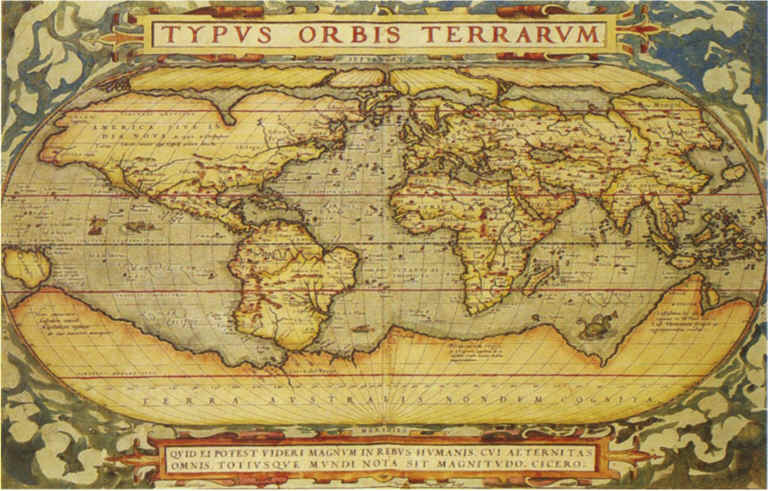In What Way is Haz-Map Like a Map?
Like a map, the goal of Haz-Map is not to collect and display isolated bits of information, but to put each detail in the perspective of the whole and to create a resource for decision support. The need for knowledge mapping is great because there is so much information about occupational exposures and diseases; it is easy to get lost in the details. The best information available from textbooks, journal articles, and electronic databases was collected, indexed, and integrated into one electronic database. The purpose is to collect and accurately represent or map the scientific knowledge about occupational exposures and diseases and thereby to improve recognition and prevention.

Figure 4. This world map was drawn by Flemish cartographer Abraham Ortelius in 1570.
Today, satellites give us essentially complete knowledge of the earth’s surface so that one can zoom-in to see a house. In 1570, a map of the world was needed even though information was limited. Today, we can map the knowledge domain of occupational toxicology realizing that knowledge is incomplete and accuracy will increase as we learn more.
The map of Ortelius shows that information was fairly complete for Europe but incomplete for the western hemisphere. Likewise, there are areas in the knowledge domain of hazardous chemicals and occupational diseases in which the information is relatively complete or incomplete. From animal experiments, case reports, and epidemiological studies, we now have fairly complete information about the potential adverse effects of the most commonly used chemicals, for example, the several hundred chemicals profiled by ACGIH. Metals are typically profiled as groups, for example, "arsenic and inorganic compounds." See this list of diseases caused by metal compounds.
For occupational diseases, see this list in Haz-Map. There is little doubt about the occupational nature of 205 of the 239 diseases in Haz-Map. There is a consensus in occupational medicine textbooks that these occupational diseases are caused by specific hazardous agents, and the diseases can be prevented by good occupational hygiene practices. The debatable categories are occupational cancers, reproductive diseases, and "more research needed." A rule in Haz-Map accepts as established occupational cancers all designated as "known human carcinogens" by IARC (International Agency for Research in Cancer) and which occur after occupational exposure.
Like a mapmaker, the domain expert who designs an intelligent database first outlines the domain and then adds details, starting with the most prominent features. The intended use of the map determines the content. Instead of simply passing on the explosion of information, it could be intelligently mapped prior to dissemination. The CDC has called the product of this kind of mapping process, "synthesized, knowledge-based information." [MMWR, Feb18, 2000/49(06); 118-120.]
Revised: February 25, 2019